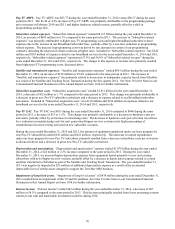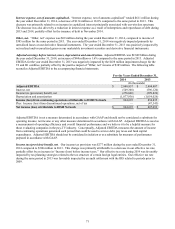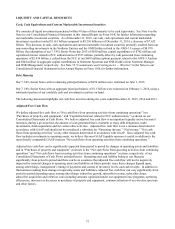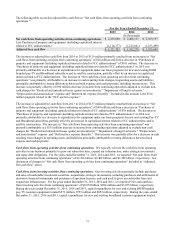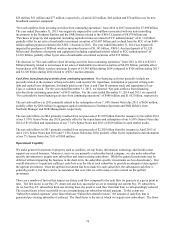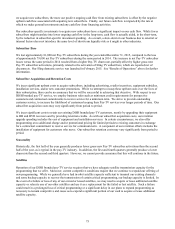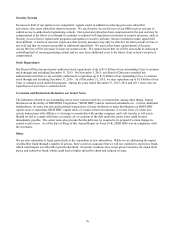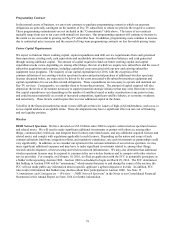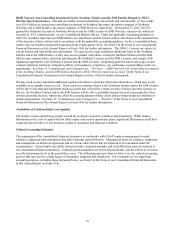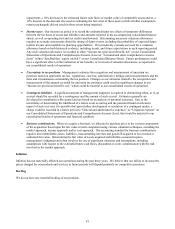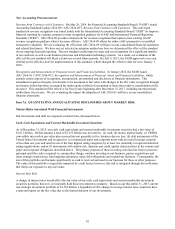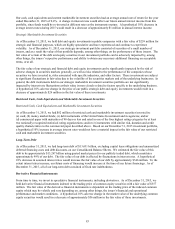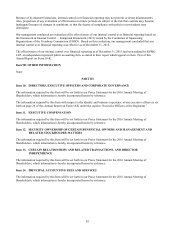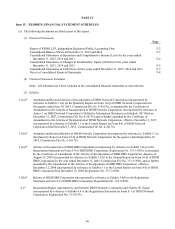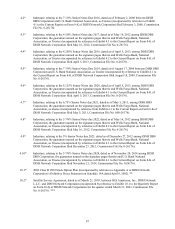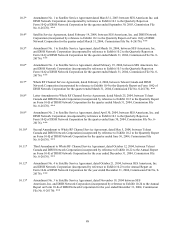Dish Network 2015 Annual Report Download - page 90
Download and view the complete annual report
Please find page 90 of the 2015 Dish Network annual report below. You can navigate through the pages in the report by either clicking on the pages listed below, or by using the keyword search tool below to find specific information within the annual report.80
x Capitalized premise equipment. Since we retain ownership of certain equipment provided pursuant to our
subscriber equipment lease programs for Pay-TV and Broadband subscribers, we capitalize and depreciate
equipment costs that would otherwise be expensed at the time of sale. Such capitalized costs are depreciated
over the estimated useful life of the equipment, which is based on, among other things, management’s judgment
of the risk of technological obsolescence. Because of the inherent difficulty of making this estimate, the
estimated useful life of capitalized equipment may change based on, among other things, historical experience
and changes in technology as well as our response to competitive conditions. Changes in estimated useful life
may impact “Depreciation and amortization” on our Consolidated Statements of Operations and Comprehensive
Income (Loss). For example, if we had decreased the estimated useful life of our capitalized subscriber
equipment by one year, annual 2015 depreciation expense would have increased by approximately $95 million.
x Accounting for investments in private and publicly-traded securities. We hold debt and equity interests in
companies, some of which are publicly traded and have highly volatile prices. We record an investment
impairment charge in “Other, net” within “Other Income (Expense)” on our Consolidated Statements of
Operations and Comprehensive Income (Loss) when we believe an investment has experienced a decline in
value that is judged to be other-than-temporary. We monitor our investments for impairment by considering
current factors including economic environment, market conditions and the operational performance and other
specific factors relating to the business underlying the investment. Future adverse changes in these factors
could result in losses or an inability to recover the carrying amount of the investments that may not be reflected
in an investment’s current carrying amount, thereby possibly requiring an impairment charge in the future.
x Valuation of long-lived assets. We review our long-lived assets and identifiable finite-lived intangible assets
for impairment whenever events or changes in circumstances indicate that the carrying amount of an asset may
not be recoverable. For assets which are held and used in operations, the asset would be impaired if the
carrying amount of the asset (or asset group) exceeded its undiscounted future net cash flows. Once an
impairment is determined, the actual impairment recognized is the difference between the carrying amount and
the fair value as estimated using one of the following approaches: income, cost and/or market. The carrying
amount of a long-lived asset or asset group is considered impaired when the anticipated undiscounted cash
flows from such asset or asset group is less than its carrying amount. In that event, a loss is recorded in
“Impairment of long-lived assets” on our Consolidated Statements of Operations and Comprehensive Income
(Loss) based on the amount by which the carrying amount exceeds the fair value of the long-lived asset or asset
group. Fair value, using the income approach, is determined primarily using a discounted cash flow model that
uses the estimated cash flows associated with the asset or asset group under review, discounted at a rate
commensurate with the risk involved. Fair value, utilizing the cost approach, is determined based on the
replacement cost of the asset reduced for, among other things, depreciation and obsolescence. Fair value,
utilizing the market approach, benchmarks the fair value against the carrying amount. See Note 8 in the Notes
to our Consolidated Financial Statements in this Annual Report on Form 10-K. Assets which are to be disposed
of are reported at the lower of the carrying amount or fair value less costs to sell. We currently evaluate our
DBS satellite fleet for impairment as one asset group whenever events or changes in circumstances indicate that
its carrying amount may not be recoverable.
x Valuation of intangible assets with indefinite lives. We evaluate the carrying amount of intangible assets with
indefinite lives annually, and also when events and circumstances warrant. During 2015, we performed a
qualitative assessment to determine whether it is more likely than not that the indefinite-lived asset’s fair value
exceeds its carrying amount. In our assessment, we assess relevant qualitative factors, including
macroeconomic conditions, overall financial performance, industry and market conditions, relevant company
specific events, and perception of the market. When our qualitative assessment is inconclusive, further analysis
is required. During 2014 and 2013, we assessed these assets quantitatively by using one of the income, cost,
and/or market approaches. While our qualitative assessment for 2015 indicated the fair value of our intangible
assets exceeded their carrying amounts, significant changes in our quantitative estimates of future cash flows or
market data could result in a write-down of intangible assets with indefinite lives in a future period, which will
be recorded in a line item entitled “Impairment of long-lived assets,” on our Consolidated Statements of
Operations and Comprehensive Income (Loss) and could be material to our consolidated results of operations
and financial condition. Based on the quantitative methodology utilized in 2014 and 2013 to test for


